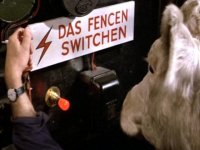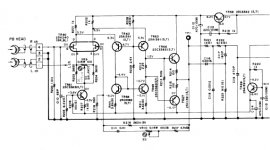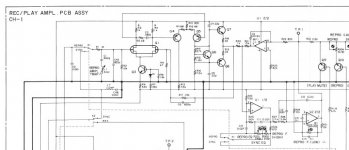What drivel. Let's all be "artists" and make crappy speakers solely by ear and forget measurements or DBTs Always some who will fight tooth and nail to NOT consider DBTs and think they have golden ears. Yeah right.
Kindhornman, if music is your hobby, you can always buy some pre-recorded tapes from yesteryear at garage sales or on evilbay and have fun. 🙂I still have a Revox A77 sitting on a shelf. Is there really any reason to use one of these machines today?
The only electronic parts that might need attention are old Frako axial electrolytics.
Putting 2 track heads on your machine would cost you some real money ($100-200), as these also fit B77 and PR99 and therefore are sought after. For 7 1/2 - 15 speed you would need a new motor - capstan shaft alone won't help, since different speed motors have different mounting offset.
P.S. FYI- there's recording engineer Dr.Frederick Bashour (Dr.Fred) who (from his own words) used A77 together with his custom Dolby A setup back in the day and produced many many good sounding classical recordings.
Last edited:
That is not just private conversation, that is exactly how most semi's are made, packaged, and sold.
Glass bead axial diodes, for example, are sandblasted from the wafer, brazed and passivated, and then they are binned by test. VF, IR, and BV sorting, so that the best ones are marked and sold at the highest price.
Transistors have been sorted that way as well. However, since they are passivated on wafer, the high voltage parameters can be tested on wafer, and they can be sorted by ink drop color.
Mil spec temps can be sorted on wafer, but that is a real PITA, especially cold testing.
jn
30 years ago this may have worked. My current employer is the largest manufacturer by volume of semiconductor devices globally at 70 billion (yes, billion) pcs a year - 90 % of that is in bipolar.
Process control is everything . . .
better than snake oil :Quantenmedizin - Rikta
Sorry, its in german.
Looks like quack medical treatments, in German - abfallen.
What drivel. Let's all be "artists" and make crappy speakers solely by ear and forget measurements or DBTs Always some who will fight tooth and nail to NOT consider DBTs and think they have golden ears. Yeah right.
High end audio is primarily a luxury goods business. Not engineering!
As long as it basically does the job (think sunscreen), looks good (think perfume packaging) and can have a useless or questionable claim(s) attached to it (think anti-ageing cream), the buyer has bragging rights and the manufacturer is good to go.
Pure art.
Could you do a DBT on anti ageing cream?
😀
Hi,
If there's anyone out there that has a system that can faithfully reproduce the sound of a piano or any other acoustic instrument for that matter to such extend that one's fooled into thinking that it's a live instrument playing then and only then I'm willing to accept that we've achieved audio nirvana.
Until then I simply refuse to accept that standard measurements as we know them tell the whole story.
All too often we assume that actual components conform to theoretical assumptions. They do not.
It is only when said components do conform to their theoretical ideals allowing us to hear and hopefully measure the difference that we come close to our ideal.
Has anyone ever measured the difference between a simple metal film resistor and its naked bulk foil counterpart?
How perfect is a cap nowadays? Is a piece of wire just that?
Of course they're not. How could they?
Does everything that measures the same is the same? No, it is not.
Measurements are just tools.
Just like computers they're not clever, the person at the other end may or may not be though.
Ciao, 😉
If there's anyone out there that has a system that can faithfully reproduce the sound of a piano or any other acoustic instrument for that matter to such extend that one's fooled into thinking that it's a live instrument playing then and only then I'm willing to accept that we've achieved audio nirvana.
Until then I simply refuse to accept that standard measurements as we know them tell the whole story.
All too often we assume that actual components conform to theoretical assumptions. They do not.
It is only when said components do conform to their theoretical ideals allowing us to hear and hopefully measure the difference that we come close to our ideal.
Has anyone ever measured the difference between a simple metal film resistor and its naked bulk foil counterpart?
How perfect is a cap nowadays? Is a piece of wire just that?
Of course they're not. How could they?
Does everything that measures the same is the same? No, it is not.
Measurements are just tools.
Just like computers they're not clever, the person at the other end may or may not be though.
Ciao, 😉
Process control is everything . . .
I know, they don't listen. Plenty of parts have 95+% yield blind assembled and unprobed simply throwing away the incomplete edge dice.
Hi,
If there's anyone out there that has a system that can faithfully reproduce the sound of a piano or any other acoustic instrument for that matter to such extend that one's fooled into thinking that it's a live instrument playing then and only then I'm willing to accept that we've achieved audio nirvana.
Until then I simply refuse to accept that standard measurements as we know them tell the whole story.
I totally agree with you, except I think it is a different paradigm. Two channels of stereo will never duplicate a 3D sound field so from the get go why bother worrying about measuring caps and wires? Forget the piano not even a vintage Gibson in the hands of a real artist. It's a simulacrum.
Attachments
Last edited:
I totally agree with you, except I think it is a different paradigm. Two channels of stereo will never duplicate a 3D sound field so from the get go why bother worrying about measuring caps and wires? Forget the piano not even a vintage Gibson in the hands of a real artist. It's a simulacrum.
Yes, but the 3D sound field is only a small part of what makes reproduced sound good or bad. There's a lot of room for improvement even in mono at present, much less multi-channel.
Hi,
It always will be a simulacrum, I grant you that but will adding more channels, more speakers make it any less so? I'd doubt that.
IME, a simple stereo system can come close to the real thing.
When we want true full bandwidth, true image of the event, then things are becoming more complex.
Do we need full bandwidth to enjoy a rendition of a musical event? I don't think so.
All we need is for it to be acceptably faithful so we can enjoy it.
Ciao, 😉
Two channels of stereo will never duplicate a 3D sound field so from the get go why bother worrying about measuring caps and wires? Forget the piano not even a vintage Gibson in the hands of a real artist. It's a simulacrum.
It always will be a simulacrum, I grant you that but will adding more channels, more speakers make it any less so? I'd doubt that.
IME, a simple stereo system can come close to the real thing.
When we want true full bandwidth, true image of the event, then things are becoming more complex.
Do we need full bandwidth to enjoy a rendition of a musical event? I don't think so.
All we need is for it to be acceptably faithful so we can enjoy it.
Ciao, 😉
Do we need full bandwidth to enjoy a rendition of a musical event? I don't think so.
All we need is for it to be acceptably faithful so we can enjoy it.
Ciao, 😉
Certainly, the importance what is missing will vary for one person to the next I don't see the point in trying to quantify that. I trust everyone here puts music on once and a while and actually enjoys it.
Elrctroj,
Thanks for the reply. My machine already does 7 1/2" speed so not to worried about getting up to the 15" pro levels. It was a nice sounding tape machine at the time. I had Sony also and was around many Ampex machines. Tascam was another of the popular machines at the time. I think I still have some old tape, not sure it won't shed but I could try and see if the electronics still work. Perhaps I can get someone to send me a few drops of oil for the motors and capstan?
Thanks for the reply. My machine already does 7 1/2" speed so not to worried about getting up to the 15" pro levels. It was a nice sounding tape machine at the time. I had Sony also and was around many Ampex machines. Tascam was another of the popular machines at the time. I think I still have some old tape, not sure it won't shed but I could try and see if the electronics still work. Perhaps I can get someone to send me a few drops of oil for the motors and capstan?
Joachim, for your ultra low noise measurement amp, are you just stacking the devices and then coupling the outputs with low value isolation resistors - like 10 ohms or something?
Easily done, Frank, have been there many times, say, with piano - what I noted at those times is that listening then to a real instrument was somewhat of a letdown - a recording usually has an instrument in excellent shape, played superbly, and recorded from an optimum position - last real grand piano I heard was in dodgy shape, all sorts of little niggles in the tonality uniformity of the notes.If there's anyone out there that has a system that can faithfully reproduce the sound of a piano or any other acoustic instrument for that matter to such extend that one's fooled into thinking that it's a live instrument playing then and only then I'm willing to accept that we've achieved audio nirvana.
Edit: What most systems fail to deliver is the subjective intensity of the sound of the instrument - for a hard stuck or blown transient to ring (pun intended) true. If this can't faithfully be projected then it will never work ...
Last edited:
Ampex AG-440 is OK, but forget the nice looking Japanese consumer junk with their stamped steel chassis, cardboard back covers and zillion of fixed tape guides. Yuck!Elrctroj,
Thanks for the reply. My machine already does 7 1/2" speed so not to worried about getting up to the 15" pro levels. It was a nice sounding tape machine at the time. I had Sony also and was around many Ampex machines. Tascam was another of the popular machines at the time. I think I still have some old tape, not sure it won't shed but I could try and see if the electronics still work. Perhaps I can get someone to send me a few drops of oil for the motors and capstan?
As to the oil, try either Studer directly (hefty markup, part. No. 20.020.401.04) or evilbay, like this one:
ReVox A77 PR99 B77 A700 C270 Tape Recorder Motor Lubricant Oil PDP65 | eBay
The rest of us also buy only few drops at a time, the oil is very expensive.
P.S. One has to give credit to Japanese, though, their tape electronics were sometimes way better than those by the "big snobbish dinosaurs".
Attachments
Last edited:
I totally agree with you, except I think it is a different paradigm. Two channels of stereo will never duplicate a 3D sound field so from the get go why bother worrying about measuring caps and wires? Forget the piano not even a vintage Gibson in the hands of a real artist. It's a simulacrum.
😎🙂
It could be a lot less expensive today to record 3D sound fields. Why arent we doing it? Laziness? Lets get back on track and move the needle some towards greater reality in audio reproduction -- at least for the Hi-End.
With many excellent IC's and also excellent but not over -the-top expensive electret mics... a huge step forward can be realized using Sound-Field recording & playback systems.
I have only heard lame reasons so far. But, Technology allows for now as the right time!
THx-RNMarsh
[In the middle of no where - Nepal]
Last edited:
- Status
- Not open for further replies.
- Home
- Member Areas
- The Lounge
- John Curl's Blowtorch preamplifier part II



